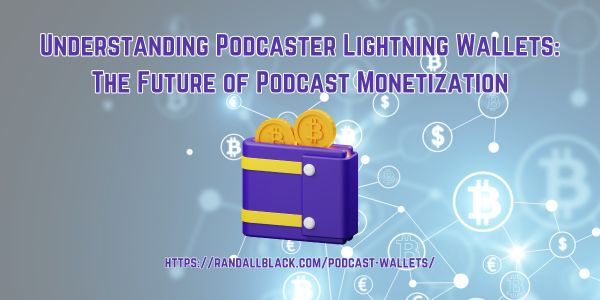Podcasting has evolved beyond traditional advertising and sponsorships. One of the most exciting innovations in the space is podcaster lightning wallets, which leverage the Bitcoin Lightning Network to enable real-time, direct payments from listeners to podcasters. This system powers the Value for Value (V4V) model, allowing fans to support creators with micropayments (satoshis or “sats”) while streaming content.
Why Podcaster Lightning Wallets Matter
- Direct Support from Listeners – Unlike traditional monetization models that rely on advertisers, lightning wallets allow podcasters to receive payments directly from their audience.
- No Middlemen – Transactions occur over the decentralized Bitcoin Lightning Network, reducing fees and increasing revenue share for the creator.
- Listener Engagement – Features like boosts (one-time tips with messages) and streaming sats (pay-per-minute listening) create a more interactive and rewarding experience for both podcasters and listeners.
- Global Accessibility – Since Bitcoin is borderless, anyone worldwide can support their favorite podcasts without worrying about currency conversion or banking restrictions.
How to Set Up a Podcaster Lightning Wallet
Setting up a lightning wallet for podcasting is easier than it sounds. Here’s a step-by-step guide:
1. Choose a Lightning Wallet
There are two main types of lightning wallets for podcasters:
Custodial Wallets (Easier to set up but managed by third parties):
- Alby (browser-based, integrates with Podcasting 2.0 apps)
- Fountain Wallet (used with the Fountain app, simple and effective)
- Wavlake Wallet (geared towards music creators but usable for podcasters)
Non-Custodial Wallets (More control but requires technical knowledge):
- Breez (self-custodial, podcast-friendly)
- Phoenix (non-custodial, easy onboarding)
2. Integrate Your Wallet with Your Podcast RSS Feed
To receive payments, podcasters must add their lightning wallet to their RSS feed using Podcasting 2.0 standards. This is usually done via:
- The Split Kit – A tool that allows podcasters to define revenue splits for hosts, guests, and contributors.
- Sovereign Feeds – A platform for creating Podcasting 2.0-compatible RSS feeds.
3. Encourage Listeners to Use Value for Value Apps
Listeners must use podcast apps that support lightning payments, such as:
- Fountain
- Podverse
- Breez
- Castopod
Encourage fans to stream sats or send boosts while they listen.
Pros and Cons of Podcaster Lightning Wallets
Pros
✔ Decentralized – No reliance on ad networks or payment processors.
✔ Lower Fees – Lightning transactions have negligible costs compared to credit card fees.
✔ Instant Payments – Sats arrive in real-time, without waiting for monthly payouts.
✔ Stronger Community Engagement – Fans can interact directly through Boost messages.
✔ Borderless – Works worldwide without banking restrictions.
Cons
✖ Requires Listener Adoption – Not all podcast listeners are familiar with Bitcoin or have a lightning wallet.
✖ Volatility – Bitcoin price fluctuations can affect earnings.
✖ Technical Learning Curve – Setting up a self-custodial wallet requires some understanding of Bitcoin and the Lightning Network.
✖ Limited App Support – While growing, not all podcast players support streaming payments.
Final Thoughts
Podcaster lightning wallets are a game-changer for creators looking to break free from ad-based monetization. While adoption is still growing, the ability to receive direct listener support in real-time offers a compelling alternative. If you’re a podcaster looking for a decentralized, engaging, and direct way to monetize your content, now is the time to explore lightning wallets.
Are you using a lightning wallet for your podcast? Let us know your experience in the comments!
